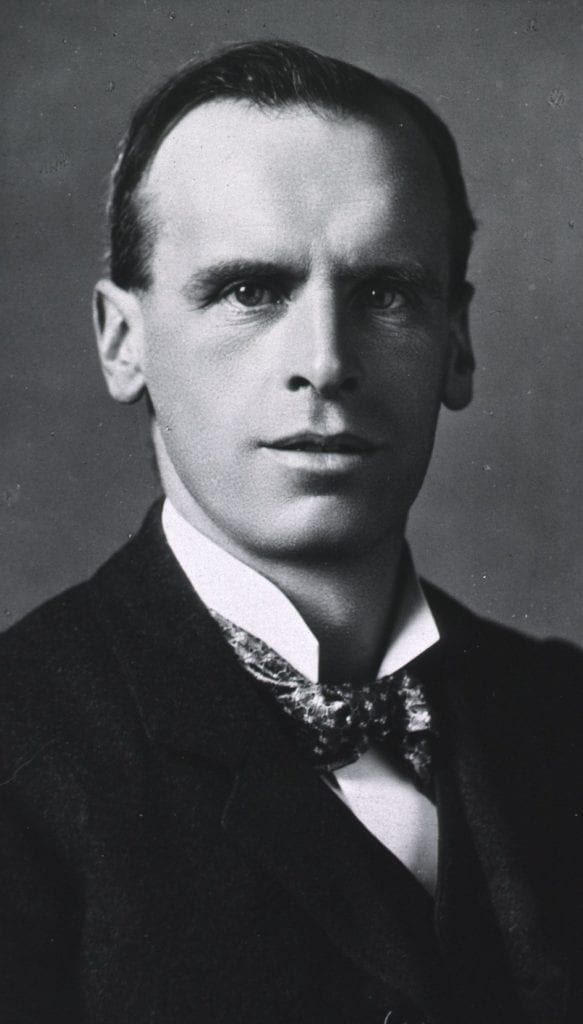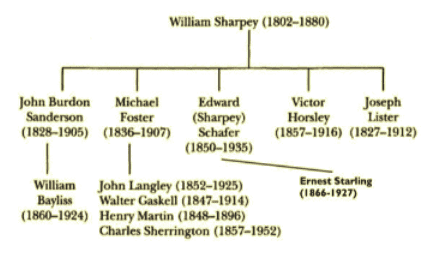JMS Pearce
Hull, England

Science has only one language, quantity, and only one argument, the experiment
-EH Starling
Ernest Henry Starling (1866-1927) (Fig 1) was an outstanding figure in the development of physiology whose prolific contributions made him one of the foremost scientists of his time. He was born on 17 April 1866 at 2 Barnsbury Square, London. He attended school in Islington and at King’s College and in 1882 entered Guy’s Hospital Medical School, graduating in 1889. Two years later he married Florence Wooldridge, daughter of Sir Edward Sieveking, MD. Described as a friendly man with a magnetic, impulsive personality he was an inexhaustible enthusiast.1
Starling appeared at a time when from an abyss of ignorance physiology was emerging as a vital and rapidly expanding discipline. The prime investigators were Claude Bernard in France; Johannes Müller, Justus von Liebig, and Carl Ludwig in Germany; and William Sharpey and Sir Michael Foster in England.
The decade spanning 1870 to 1880 arbitrarily signposts the birth of British physiology. Before this time it was anatomists, physicians, and surgeons such as Bell, Marshall Hall, Bright, and Addison who contributed to physiological knowledge. On 31 March 1876, nineteen men (Fig 2) met at the house of John Burdon Sanderson to discuss the formation of The Physiological Society for “promoting the advancement of physiology and facilitating the intercourse of physiologists.”2 An inaugural dinner was held at the Criterion restaurant, Piccadilly. The Society met at Sanderson’s London home.3 Membership was restricted to forty working physiologists; women were first admitted in 1915. Michael Foster founded The Journal of Physiology in 1878, and held the first Chair of Physiology at Cambridge in 1883.
At University College London (UCL) Starling was in a direct line of peerless physiologists4 who labored to uncover a throng of bodily functions then unknown. William Sharpey, Professor of Anatomy and Physiology, John Burdon Sanderson, and Sir Michael Foster were central figures, succeeded by a galaxy of talented scholars and researchers including two eminent surgeons.
Starling’s fundamental discoveries
Michael Foster had moved to Cambridge in 1870, and when Sir Edward Sharpey-Schafer secured the Edinburgh Chair of Physiology in 1899 Starling replaced him at UCL.5 Starling was a pioneer of endocrinology but his name is associated with a plenitude of other major discoveries—each a fundamental advance.
He had in 1894 investigated lymph secretion and the mechanism of fluid exchange between vessels and tissues.6 In 1896 he propounded Starling’s sequence, or hypothesis. It stated that because the capillary wall acted as a semipermeable membrane allowing passage of salt solutions, the hydrostatic pressure forcing these solutions into tissues was balanced by the osmotic pressure—generated by colloidal solutions in the capillaries–forcing absorption of fluid from the tissues.7

He developed a heart-lung preparation that enabled him to formulate Starling’s law of the heart, stating that the force of muscular contraction of the heart is directly proportional to the extent to which the muscle is stretched in diastole.8
With Bayliss he showed rhythmic pendular myogenic movements of the intestine, and the true peristaltic reflexes triggered by stimulation of the gut, effected by the splanchnic and vagus nerves via Auerbach’s plexus.9
In later years Starling experimented on kidney function and found that water, chlorides, bicarbonates, and glucose in the excretory filtrate are reabsorbed by the distal renal tubules.
Secretin
As Jodrell professor of physiology at UCL, Starling the impatient, and sometimes impulsive visionary began a successful collaboration with his brother-in-law, the physiologist William Bayliss, a more cautious partner.
Physicians in the mid-nineteenth century knew of ductless glands which fed into blood vessels (blutdrüsen; blood-glands), but this was a purely anatomical concept. In 1902 Bayliss and Starling isolated a substance from dogs’ stomachs that they called secretin, which defined hormonal function:
The contact of the acid [chymei] with the epithelial cells of the duodenum causes in them the production of a body (secretin), which is absorbed from the cells by the blood-current, and is carried to the pancreas, where it acts as a specific stimulus to the pancreatic cells, exciting a secretion of pancreatic juice.”10
They deduced that substances were released in a restricted part of the body (endocrine gland), carried by the bloodstream to unconnected parts, where in small quantities they are capable of profoundly influencing the function of those parts. Two years later Starling coined the term hormone.
The word first appeared in 1905, when he gave the Croonian Lectures of the Royal College of Physicians (Fig 4) having given a Croonian lecture to the Royal Society in the previous year. There were four lectures.11 The first was The Chemical Control of the Functions of the Body. In it he surprised his audience when he declared:

These chemical messengers, however, or hormones (from óρμáω, I excite or arouse) as we might call them, have to be carried from the organ where they are produced to the organ which they affect by means of the blood stream and the continually recurring physiological needs of the organism must determine their repeated production and circulation throughout the body.
His second lecture concerned gastric secretin, and the third the control of pancreatic secretion. In the fourth lecture he dealt with function of the thyroid, ovaries, and testes. But where did he find the word “hormone” used in his first and fourth lectures?
Apparently, when talking to the eminent biologist WB Hardy, who had invited him to a dinner in Caius College, Cambridge they agreed that a word was needed for an agent released into the blood stream that stimulated activity in a different part of the body. Their colleague, W.T. Vesey (a Greek scholar of Pindar and Cicero) suggested the Greek verb óρμáω [ormao] for “excite” or “arouse” and, to quote Needham, “The deed was done.”12
In time Starling’s health deteriorated but he continued his research with fellows and students from all over the world.
Glandular secretion before Starling
Neither hormones nor glandular secretion had been defined before Starling. His work rested on earlier studies, which had hinted that certain organs yielded factors circulated by the blood that affected the workings of distant vital structures. We can see an inkling of hormonal mechanisms in the work of Thomas Wharton (1614-73), physician to St. Thomas’ Hospital. His lengthy Latin text Adenographia, sive, Glandularum totius corporis descriptio, (1656) stated:

We may certainly believe of the [adrenal] glands . . . that material is not completely excreted but is used since it is received continually by the veins.
Disordered endocrine function was clinically described by Thomas Addison’s (1849) account of a syndrome caused by disease of the suprarenal glands. In 1855 Claude Bernard and Charles Édouard Brown-Séquard (1817–1894) showed hormonal, internal secretion in mammals but no generic name for hormones had been invented. Forty years later the Harrogate physician George Oliver (1841-1915) with Edward Sharpey-Schäfer showed the vascular effects of suprarenal extract:13 the first physiological demonstration of hormonal action in man.14 This discovery was the essential precursor of the modern neurotransmitter chemistry. In the same decade George Murray and Victor Horsley demonstrated that myxedema could be reversed by extracts of thyroid tissue.
———
Under Starling a physiological institute at University College was opened in 1909. In 1922 he was elected Foulerton Research Professor of the Royal Society. At the Royal College of Physicians Starling delivered the Croonian Lectures—On the chemical correlation of the functions of the body; the Oliver-Sharpey Lectures—On the feeding of nations; and the Harveian Oration—The wisdom of the body; and was thrice Arris and Gale lecturer at the Royal College of Surgeons.7 Both his books, Elements of Human Physiology (1892) and Principles of Human Physiology (1912), earned high praise as standard works. The former was continually revised with a paperback 14th edition in 1968.15
In 1920 he was operated on for cancer of the colon and survived episodes of pulmonary embolism. He continued to work but seven years later died aboard a ship while on a Caribbean cruise, and was buried at Kingston, Jamaica.
After this golden era the UCL basic sciences continued to thrive. Nobel Prize-winners include Archibald Hill for his work on muscle function, Andrew Huxley for the discovery of the mechanisms of initiation and propagation of the nerve impulse, and Bernard Katz for his research on synaptic transmission. James Black received the Nobel Prize for his work on β-blockers and histamine H2 receptor antagonists. Ivan Roitt and Deborah Doniach discovered thyroglobulin autoantibodies in Hashimoto’s thyroiditis, which opened the whole concept of autoimmune disease.
Note
- Chyme is the mass of partly digested food and gastric acid that is expelled by the stomach into the small intestine.
References
- Martin C J. Ernest Henry Starling, C.M.G., M.D., F.R.S. British Medical Journal 1927;1(3462):900-906
- Bynum WF. A short history of the Physiological Society, 1926-1976. Journal of Physiology 1976; 263: 23-72.
- Sharpey-Schafer E. History Of The Physiological Society During Its First Fifty Years, Part.1. J.Physiol 1927; 64 (Suppl), 1–76.
- O’Connor WJ. Founders of British Physiology. A Biographical Dictionary, 1820-1885. Manchester University Press, 1988.
- Henderson J. A Life of Ernest Starling. Academic Press 2005.
- Starling EH. The influence of mechanical factors on lymph production. Journal of Physiology, Cambridge, 1894, 16: 224-267.
- Starling E. On the absorption of fluids from the connective tissue spaces. Journal of Physiology 1896; 19: 312-326.
- Starling EH. The Arris and Gale Lectures on Some Points in the Pathology of Heart Disease. (four lectures).Lancet, 1897, 1: 569-572, 652-655, 723-726.
- Bayliss WM, Starling EH. The movements and innervation of the small intestine. J Physiol (Lond) 24:8-143, 1899.
- Bayliss WM, Starling EH. The mechanism of pancreatic secretion. J Physiol. 1902;28(5):325-53.
- Starling E. Croonian Lectures: On the chemical correlation of the functions of the body Lancet 1905;2:. 2339–341; 2423–425. 2501–503. 2579–583.
- Needham J. ‘Order and Life’ Yale Univ. Press,1936; p.80
- Oliver G, Schafer E A. The physiological effects of extracts of the suprarenal capsules’, J. Physiol., 1895;18:230-76.
- Pearce JMS. Links Between Nerves and Glands: The Story of Adrenaline. Advances In Clinical Neuroscience & Rehabilitation 2009;9 (5) 22-9.
- Starling EH. Principles of Human Physiology. London, 1912; 5th edition, with Charles Arthur Lovatt Evans. 1930; 14th edition, 1968.
JMS PEARCE, MD, FRCP, is emeritus consultant neurologist in the Department of Neurology at the Hull Royal Infirmary, England.

Leave a Reply